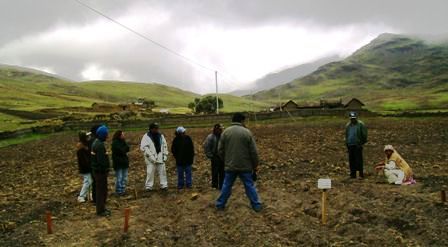THE SANREM CRSP @ MU
The Sustainable Agriculture and Natural Resource Management Collaborative Research Support Program
Adapting to Change in the Andean Highlands:
Practices and Strategies to Address Climate and Market Risks in Vulnerable Agro-ecosystems

SPECIFIC OBJECTIVES & ACTIVITIES
Objective 1 : “Develop a shared understanding of the ecosystem, and the social and economic drivers of change in highland vulnerable communities.” Integrate through participatory research, disciplinary and holistic understanding of system’s constraints, to develop measures and indicators of ecosystem and livelihood wellbeing.
Activities:
1.1 Baseline Assessment of Community Household and Individual Livelihoods and Production Systems
1.2 Comparison of organic matter under different management regimes and perceptions of soil quality
1.3 Identification of major plant pests, diseases and their incidence in recent years.
1.4 Identify changes in the production systems and biodiversity due to climate change
Objective 2: “Understand how livelihood strategies are developed in response to farmer perceptions of the relative risks of these changes; and how these perceptions are linked to their assets (livelihoods)” Evaluate Farmer Perception of Soil Conditions, Production Systems Changes, and Pests, Diseases, and Climate Risks.
Activities:
2.1 Quantify the risks perceived by farmers and communities.
2.2 Identify local systems of soil classification for soil organic matter and for quality of organic inputs and compare them to actual measurement of soil organic matter and organic input composition
2.3 Determine the conditions leading to elimination of woody plants from fallow systems
2.4 Evaluation of past 35 years of weather data to determine exact nature of weather risks.
2.5 Perceptions of weed, pest (Andean weevil, and potato tuber moth) and disease (early blight) problems and comparing them with actual practices.
2.6 Community-livestock-rangeland/water interaction management and of environmental risk in Puno
Objective 3: “Link local and new knowledge to produce practices and information that provide alternatives for adapting to change.” Develop Practices (specific interventions in soils, disease and pest management, biodiversity, crop varieties) and Dissemination Strategies (networks to access new information)
Activities:
3.1 Study of climate change impact on the production system and interventions. Study new opportunities or potential changes of cropping strategies of farming systems in response to climate change
3.2 On-farm testing of early maturing varieties of quinoa
3.3 Model evaluation of use of different cropping systems under different climate conditions
3.4 Evaluate current management strategies to control pests and disease
3.5 Evaluate benefits of protecting bio-diversity in fallow areas and of alternative tillage and manure use strategies
3.6 Study of biodiversity of native potato varieties, erosion, management and conservation
3.7 Study local knowledge of climate variability: develop information on climate conditions and forecasts
3.8 Study information flows within and among groups of producers in communities and between communities
3.9 Evaluation of current NNRR management strategies for animal production and farmers capacity to environmental change adaptation
Objective 4: Develop market access through strategies and institutions that contribute to resilience. We define resilience as the ability of people and their environments to recover from shocks and stresses
Activities:
4.1 Evaluation of market behavior and individual transaction costs
4.2 Assessment of the agricultural systems to identify market opportunities, potential for traditional Andean tubers and native crops
4.3 Evaluation of feasibility of financial institutions
4.4 Identification of markets for alternative crops
Objective 5: Strengthening Capacities and Capabilities. Our underlying approach is to share capacities across disciplines (bio-physical, social sciences), across countries, rural communities, research and development communities, and stakeholders.
Activities:
5.1 Annual Stakeholder Participatory Planning Meeting
5.2 Integrated teams of biophysical, socio, economic researchers and farmers.
On farm experimentation and participatory research with farmers. Farmer Field Schools.5.3 Farmer group to farmer group sharing of experiences, and coalition building
5.4 Training of graduate students and last year “licenciatura” students in multi-disciplinary research approaches through participation in research in the communities
5.5 Module of participatory extension UNALM graduate program. Formal training and research training for Bolivian Peruvian and US graduates.


